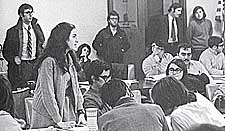Student Government Feature Of
Campus Life For More Than 100 Years
 |
|
Picture from the Past. Leaders of the Associated Student Government debate an issue in 1970. |
| Photo from University Archives |
Under various names, student government has been a part of campus life for 111 of the University’s 123-year history, serving as a liaison between students and the administration, and giving students a voice in the governance of the institution.
The first version of student government was called the Students’ Organization. Formed in 1894, a year after Storrs Agricultural School had been renamed Storrs Agricultural College, it consisted of nine students, chosen by the faculty, out of a student population of 145.
The earliest record of the Students’ Organization is a list of officers in the first issue of the student newspaper, The Lookout, in May 1896. Its president at that time was John Nelson Fitts, a member of the Class of 1897, who later became the college’s first dean of engineering.
An early issue for student government– and about the only one reported in The Lookout prior to 1900 – was a college policy making it compulsory for male students to provide manual labor three hours each day.
“One of the most important matters now before the Students’ Organization,” said a Lookout editorial in April 1897, “is that of the ‘labor question.’ We want no compulsory labor except what may be necessary for the purposes of education. Everyone is agreed that the present system is very expensive to the College, and not of much benefit to the boys, as all the good they derive is in the exercise and eight cents an hour.”
Over the next year, the faculty eliminated compulsory labor, and athletics began to take up more of the students’ leisure time.
In the early 1900’s, the entire student body made up the Students’ Organization, the legislative branch of government, while the Student Council was the executive branch. The council and the co-existent Women’s Student Government Association, both elected bodies, had some regulatory and disciplinary powers.
The Student Council could, “for just cause,” recommend to a faculty committee suspension or dismissal of any student. Surviving correspondence with President Charles L. Beach indicates that the Student Council frequently made these recommendations, and that they were approved by the administration.
The impact of the Students’ Organization and Council must have waned considerably over the next two decades, for in 1918, the faculty “proposed a plan of student self-government” that apparently led to the formation of the Student Senate in 1922. The Senate had 11 members: six seniors, four juniors, and one second-year student from the two-year School of Agriculture. Sophomores and freshmen were not included.
The Student Senate was to be the most enduring form of student self-governance, surviving until the 1970’s as part of what became known in the 1930’s as the Associated Student Government (ASG).
Another long-lasting student government entity was the Women’s Student Government Association, which existed in parallel to the Students’ Organization and its successors. The WSGA was chartered in 1918, initially to deal with issues relating to the only women’s dormitory on campus at the time, Grove Cottage. Grove burned down the following year, but the WSGA survived and expanded to include all subsequent women’s dormitories.
The WSGA was launched at the end of World War I, during which women students held student government positions for the first time. Most men were enrolled in an army training program during the war, and upon their return to regular classes they displaced women in various roles of student authority. Women did not fill those roles again until the 1940’s, during World War II, but their participation became permanent following that war’s end in 1945.
In the later half of the 20th century, UConn’s student government debated a variety of issues, but its chief responsibility was control over the budgets of other student organizations.
In 1973, the Student Senate and the ASG were replaced by the Federation of Student and Service Organizations. The reorganization grew, in part, out of the radical politics of the day. Students protesting the war in Vietnam were questioning authority across the board, and that included questioning student leaders.
For the ASG election in the spring of 1972, the Connecticut Daily Campus questioned not only the election process, but the effectiveness of the ASG. In a series of editorials, the newspaper called for a vote of no confidence, urging students to write the name of the fictitious Bill X. Carlson on the ballot for ASG president and vice president.
The Carlson phantom received more than 1,600 votes for president and nearly 900 for vice president. Still, the Student Senate swore in the losing endorsed candidates following the election. A week later, following the administration’s call for a review of student government, the Senate voted for a reconsideration of the role of student government and the redrafting of the student government constitution.
A constitutional convention resulted in students approving creation of the Federation of Student and Service Organizations (FSSO), which encompassed the Student Union Board of Governors, the Residence Hall Council, and the Commuters’ Union. A Central Committee, similar to the Senate, was the legislative body.
In 1980, the FSSO was itself dissolved and replaced by the Undergraduate Student Government (USG), also with three constituent units: the Activities Union (SUBOG); Resident Student Assembly; and Commuters’ Union. USG continues to function.

